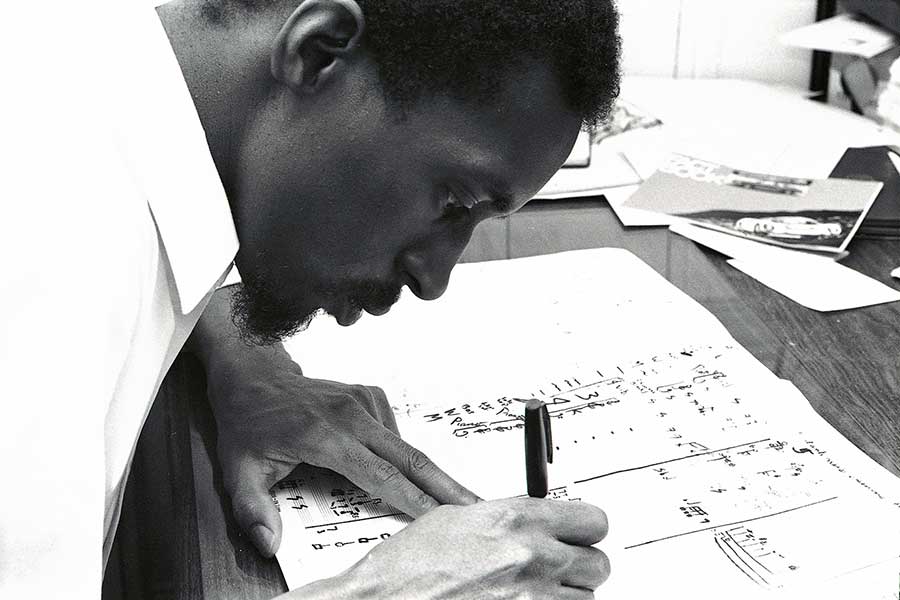From May 4-28, Philadelphians can immerse themselves in the music and life of Julius Eastman, a composer and performer whose work was beautiful, challenging and unapologetically queer.
“Julius Eastman: That Which Is Fundamental” is a retrospective that includes four concerts and an accompanying exhibit. It is presented by Bowerbird, a local arts organization whose mission is showcasing experimental music, in collaboration with The Rotunda and the Slought Foundation.
Eastman, who died in 1990, may not be a household name, but among people interested in contemporary classical music, his renown is growing.
Born in 1940, Eastman studied composition at Philadelphia’s Curtis Institute, then migrated to Buffalo, N.Y., to participate in the Creative Associates program, which co-curator Dustin Hurt, the director of Bowerbird, described as “a sort of new music utopia that existed in the ’60s and ’70s.”
Eastman was an accomplished pianist and an in-demand baritone. His portrayal of George III in Peter Maxwell Davies’s “Eight Songs for a Mad King,” for example, earned him a Grammy nomination.
But Eastman began to grow dissatisfied. In a 1976 interview, he told Renate Strauss, “What I am trying to achieve is to be what I am to the fullest — Black to the fullest, a musician to the fullest, a homosexual to the fullest.”
Moving to Manhattan, Eastman still occasionally performed with orchestras, but he was increasingly drawn to the downtown scene, where genres and ideas mixed freely. Always principled and sometimes provocative, his career began to derail in the 1980s, a situation exacerbated by personal problems. Even before Eastman died in 1990, his possessions, including his scores, were scattered or lost outright.
The current retrospective is just one effort to draw attention to Eastman’s work. According to Hurt, it “is like the culmination of a pretty long research project.”
Hurt first encountered Eastman in 2007, while researching other composers. Intrigued, he tried to learn more, only to find out that details of Eastman’s life were sketchy and recordings of his work were rare. Eventually, he found others who were trying to preserve Eastman’s work, like the composer Mary Jane Leach and the librarian John Bewley. It wasn’t until 2014, though, that work on the retrospective began in earnest.
“One of the things that’s interestingly happened in that time is Julius Eastman has become kind of a composer flavor of the moment,” Hurt said.
In just the past year, Eastman has been the subject of appreciative articles in The New Yorker and The New York Times. The record label Frozen Reeds released the premier recording of an early work, “Femenine.” There is also now a collection of critical essays about him called “Gay Guerrilla: Julius Eastman and His Music.”
The retrospective’s first concert takes place May 5 at the Rotunda. The program includes “Femenine” and “Stay on It,” two early pieces.
According to Hurt, “The music that Eastman has become known for is a type of minimalist music that has a unique combination of pop-music influences in terms of harmonies and a use of improvisation.” Those elements, he added, give Eastman’s music a looser, more vital feel than the work of other minimalists.
Eastman also challenged audiences with pieces that were political and, sometimes, provocative. That’s the case with pieces like “Crazy Nigger” and “Gay Guerrilla,” which will be performed May 19.
One goal of the retrospective, Hurt said, is “to present a much wider view of Eastman as an artist, to show a broader range of his musical talents and musical interests.”
To flesh out Eastman’s life, the retrospective’s two exhibits, “A Recollection” and “Predicated,” should help. Both were put together by co-curator Tiona Nekkia McClodden, a filmmaker and visual artist whose work explores black queer history.
“A Recollection” includes artifacts and ephemera associated with Eastman. He didn’t actively archive his own work and what he did save was largely lost, so the bulk of this material was gathered from his family, friends and lovers. In “Predicated,” 10 contemporary artists, all people of color, engage with Eastman’s work.
To McClodden, Eastman’s work is inspirational and relevant. “We’re living in transgressive times but at the same time very conservative times,” she said. “So it’s refreshing, I think, to be able to look at someone who was really pushing it at a time where people thought that wasn’t happening and bring that current where we want it to happen.”
Eastman was a complex, contradictory person whose life included artistic accomplishments and painful setbacks. It would be a mistake, however, to view him as tragic.
“When you’re an artist, you’re confronted with these spaces of partitioning yourself, and I see Eastman as someone who refused it,” McClodden said. “That’s something that I try to refuse every day, so he gives me courage.”
To learn more about Eastman, visit www.thatwhichisfundamental.com.
